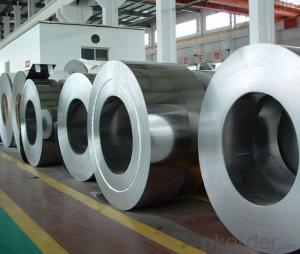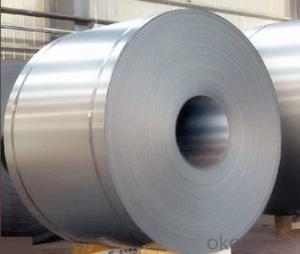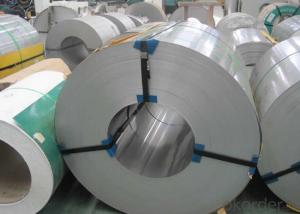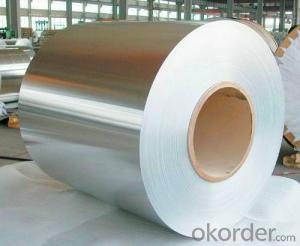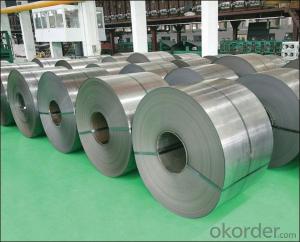Hot / Cold Rolled Stainless Steel Coil 201
- Loading Port:
- Lianyungang
- Payment Terms:
- TT OR LC
- Min Order Qty:
- 100 m.t.
- Supply Capability:
- 5000 m.t./month
OKorder Service Pledge
OKorder Financial Service
You Might Also Like
Hot Rolled Stainless Steel Coil 201 Narrow Strip No.1 Finish
Hot Rolled Stainless Steel 201 half copper Chemical Composition(%) | |||||||
C | Si | Mn | P | S | Ni | Cr | Cu |
0.1 | 0.5 | 10 | 0.04 | 0.01 | 1.20/1.30 | 13.00/14.00 | 0.8/1.0 |
Grade: | 200 Series | Standard: | JIS,AISI,ASTM,GB,DIN | Thickness: | 2.5/3.0/4.0mm |
Width: | 485/510/550/610/1010/1240mm | Place of Origin: | Shanghai China (Mainland) | Brand Name: | CNBM |
Model Number: | 201 | Technique: | Hot Rolled | Application: | Industrial tubes/kitchen/bath |
Certification: | ISO | THK: | 2.5/3.0/4.0mm | Face: | No.1 |
Usage: | tubes/kitchen/bath | Origin: | CHINA | ||
Packaging Detail: For customer's requirement
Delivery Detail: 10-30days
201 Hot Rolled Stainless Steel Coil Specifications
THK:2.3/2.5/3.0/4.0mm
Width:485/510/550/610/1010/1240mm
Face:No.1
201 Hot rolled stainless steel Coil Application
Stainless steel is a production which not easy rust,acid resistance and corrosion resistance,so it is widely
used in light industry,heavy industry,daily necessities and the decoration industry.
201 hot rolled stainless steel coil, use to produce cold rolled stainless steel coil and stainless steel tube, pipe.
201 Hot Stainless Steel Coil Chemical Composition(WT%)
(C):≤0.15, (Si):≤0.75, (Mn):5.5~7.50, (Cr):16.0~18.0, (N):≤0.25, (Ni):3.50~5.50, (P):≤0.060, (S):≤0.030
201 Hot Rolled Stainless Steel Coil
Strength Of Extension:100,000 To 180,000 Psi;
Yield Strength:50,000 To 150,000 Psi
Elongation :55 To 60%;
Modulus Of Elasticity:29,000,000 Psi;
Density :.280lbs/Cubic Inch(7.93g/Cm3)
- Q:Can stainless steel strips be used in heat-resistant applications?
- Yes, stainless steel strips can be used in heat-resistant applications. Stainless steel has excellent heat resistance properties, including high melting points and resistance to oxidation and scaling at elevated temperatures. This makes it suitable for various heat-resistant applications such as construction, automotive, aerospace, and industrial equipment.
- Q:Are stainless steel strips resistant to UV radiation?
- Yes, stainless steel strips are highly resistant to UV radiation. Due to their composition and protective oxide layer, stainless steel strips are able to withstand prolonged exposure to sunlight and UV radiation without significant degradation or damage.
- Q:What are the weight and length options for stainless steel strips?
- The weight and length options for stainless steel strips can vary depending on the specific requirements and specifications of the project or application. Stainless steel strips typically come in a range of thicknesses, widths, and lengths to cater to different needs. Common weight options for stainless steel strips range from light to heavy, with varying thicknesses and widths available. Similarly, the length options can vary from shorter lengths suitable for small projects to longer lengths for larger applications. It is important to consult with suppliers or manufacturers to determine the specific weight and length options available for stainless steel strips based on your requirements.
- Q:What are the different surface finishes available for stainless steel strips?
- There are several surface finishes available for stainless steel strips, including mill finish, brushed finish, mirror finish, satin finish, and patterned finish.
- Q:How is stainless steel strip manufactured?
- The process of manufacturing stainless steel strip includes shaping and cutting stainless steel sheets. To start, high-quality stainless steel alloy is selected, typically containing chromium and nickel, which provides durability and resistance to corrosion. The manufacturing process begins by feeding the stainless steel sheets into a rolling mill, where they pass through multiple sets of rollers. These rollers gradually reduce the thickness of the sheets, resulting in a thinner and longer strip. This rolling process is repeated multiple times to achieve the desired thickness and dimensions. After the rolling process, the stainless steel strip undergoes annealing to remove internal stresses and improve its ductility. Annealing involves heating the strip to a specific temperature and then slowly cooling it. This process enhances the mechanical properties of the strip and makes it easier to work with in subsequent manufacturing steps. Once annealed, the strip may undergo additional processes depending on the desired end-use. These processes may include pickling or passivation to remove impurities or oxides and improve the surface finish. The strip may also be coated or polished to enhance its appearance or protect it from corrosion. Finally, the strip is cut into the desired lengths using shearing or slitting machines. Shearing involves cutting the strip in a straight line to create individual pieces of the desired width. Slitting, on the other hand, involves cutting the strip into narrower widths, commonly used for applications such as flexible metal hoses or electrical components. Overall, precise control of rolling, annealing, and cutting processes is essential in the manufacturing of stainless steel strip to ensure the production of high-quality strips that meet required specifications and standards. These stainless steel strips are widely used in various industries such as automotive, aerospace, construction, and manufacturing due to their excellent corrosion resistance, strength, and versatility.
- Q:Can stainless steel strips be used in cryogenic applications?
- Yes, stainless steel strips can be used in cryogenic applications. Stainless steel is known for its excellent resistance to extreme temperatures, including low temperatures found in cryogenic environments. It retains its strength and integrity even at very low temperatures, making it suitable for use in cryogenic applications. Additionally, stainless steel has good corrosion resistance, which is essential in cryogenic environments where moisture and other corrosive elements may be present. Overall, stainless steel strips are a reliable and durable choice for use in cryogenic applications.
- Q:How do stainless steel strips resist embrittlement in high-temperature applications?
- The exceptional resistance to embrittlement in high-temperature applications is a well-known characteristic of stainless steel strips. This resistance can primarily be attributed to the unique composition and microstructure of stainless steel. Stainless steel, being an alloy, contains a significant amount of chromium, typically ranging from 10-30%. The presence of chromium in stainless steel plays a crucial role in its ability to resist embrittlement. One of the reasons for this is that chromium forms a passive oxide layer on the surface of stainless steel, known as chromium oxide or Cr2O3. This oxide layer acts as a protective barrier, preventing the diffusion of harmful elements and reducing the vulnerability to embrittlement. In high-temperature environments, stainless steel strips are able to retain their resistance to embrittlement due to the stability of the chromium oxide layer. Even at elevated temperatures, this layer remains intact, providing a continuous barrier against the corrosive and embrittling effects of the surrounding environment. Moreover, stainless steel also contains other alloying elements such as nickel and molybdenum, which contribute to its strength at high temperatures and its resistance to embrittlement. These elements enhance the stability of the microstructure, preventing the formation of brittle phases and maintaining the ductility of the stainless steel strips. The fine-grained microstructure of stainless steel is another crucial factor in its resistance to embrittlement. The presence of fine grains inhibits the propagation of cracks and reduces overall susceptibility to fracture, even at high temperatures. Additionally, the presence of carbides, nitrides, or other precipitates within the stainless steel matrix can help immobilize dislocations and prevent their movement, further enhancing the resistance to embrittlement. In conclusion, the resistance of stainless steel strips to embrittlement in high-temperature applications is attributed to the protective chromium oxide layer, the presence of alloying elements, the stability of the microstructure, and the inhibiting effects of precipitates. These factors work together to ensure that stainless steel maintains its strength, ductility, and resistance to fracture, even under extreme temperature conditions.
- Q:What are the storage and handling recommendations for 111 stainless steel strips?
- The storage and handling recommendations for 111 stainless steel strips include storing them in a clean, dry, and well-ventilated area to prevent moisture and corrosion. It is advisable to stack them on pallets or racks to avoid contact with the ground and minimize the risk of damage. Additionally, handling should be done with clean gloves or tools to prevent contamination and scratches on the surface. Regular inspection for any signs of damage or corrosion is also recommended.
- Q:Can stainless steel strips be used in pharmaceutical industries?
- Yes, stainless steel strips can be used in pharmaceutical industries. Stainless steel is a preferred material in pharmaceutical manufacturing due to its excellent corrosion resistance, high strength, and durability. It is used in various applications such as equipment fabrication, storage tanks, piping, and fittings. Stainless steel is easy to clean and sterilize, which is crucial in maintaining the highest levels of hygiene and preventing contamination in pharmaceutical production environments. Additionally, stainless steel strips offer versatility in terms of size, thickness, and surface finishes, making them suitable for a wide range of pharmaceutical industry requirements.
- Q:How do stainless steel strips perform in the presence of sulfuric acid?
- Stainless steel strips generally exhibit good resistance to sulfuric acid under certain conditions. The performance of stainless steel in the presence of sulfuric acid depends on several factors including the concentration and temperature of the acid, the grade of stainless steel, and the duration of exposure. In general, stainless steel is resistant to dilute sulfuric acid solutions (up to 10%) at room temperature. The passive film that naturally forms on the surface of stainless steel provides excellent protection against corrosion in these conditions. The resistance can vary depending on the specific grade of stainless steel, with austenitic stainless steel (such as 304 and 316) offering better corrosion resistance than ferritic or martensitic grades. However, as the concentration of sulfuric acid increases or the temperature rises, the corrosion resistance of stainless steel can be compromised. At higher concentrations (above 10%) or elevated temperatures, stainless steel may experience localized corrosion, including pitting or crevice corrosion. Under such conditions, it is common to use higher alloyed stainless steels, such as duplex or super duplex grades, which offer enhanced resistance to sulfuric acid. It is important to note that prolonged exposure to sulfuric acid can eventually lead to corrosion even in stainless steel. Therefore, it is advisable to limit the exposure time and concentration of the acid to minimize the risk of corrosion. Additionally, proper maintenance and regular cleaning can help maintain the corrosion resistance of stainless steel in the presence of sulfuric acid.
1. Manufacturer Overview |
|
|---|---|
| Location | |
| Year Established | |
| Annual Output Value | |
| Main Markets | |
| Company Certifications | |
2. Manufacturer Certificates |
|
|---|---|
| a) Certification Name | |
| Range | |
| Reference | |
| Validity Period | |
3. Manufacturer Capability |
|
|---|---|
| a)Trade Capacity | |
| Nearest Port | |
| Export Percentage | |
| No.of Employees in Trade Department | |
| Language Spoken: | |
| b)Factory Information | |
| Factory Size: | |
| No. of Production Lines | |
| Contract Manufacturing | |
| Product Price Range | |
Send your message to us
Hot / Cold Rolled Stainless Steel Coil 201
- Loading Port:
- Lianyungang
- Payment Terms:
- TT OR LC
- Min Order Qty:
- 100 m.t.
- Supply Capability:
- 5000 m.t./month
OKorder Service Pledge
OKorder Financial Service
Similar products
New products
Hot products
Hot Searches
Related keywords
